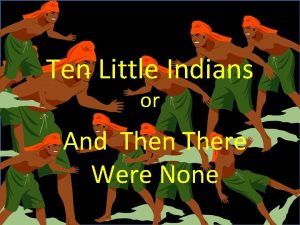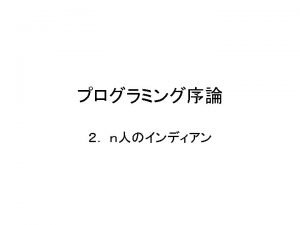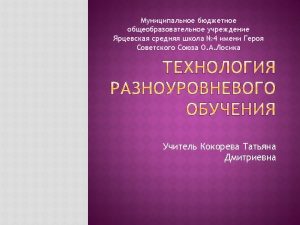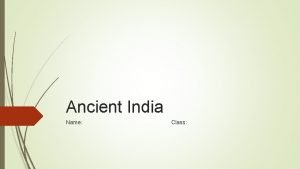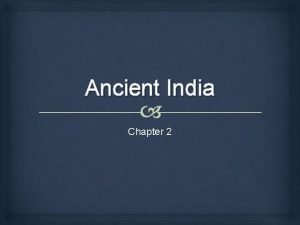Ancient India Ancient India We know very little










- Slides: 10

Ancient India

Ancient India • We know very little about this civilization, but what we know is fascinating! Over 4, 000 years ago, in the Indus Valley, people built huge, planned cities, with straight streets, and brick homes with private baths! • Kids played with toys and women wore lipstick! • How do we know this? In 1922, archaeologists found something exciting! They found the remains of an ancient city called Harappa. They found another city, located 400 miles southwest of Harappa, called Mohenjo-Daro. Other ancient cities from the same period, arranged in the same way, have been found since. Collectively, this civilization is referred to as the Indus Valley Civilization (sometimes, the Harappan civilization). This civilization existed from about 30002, 500 BCE to about 1500 BCE, which means it existed at about the same time as the Egyptian and Sumerian civilizations.

Ancient India • What was life like, over 4, 000 years ago, in Harappa and in Mohenjo -Daro, two busy cities of about 35, 000 people each? Would you have wanted to live in one of these flourishing ancient cities? (I think they sound neat!) Let's see what you think! • Homes: Houses were one or two stories high, made of baked brick, with flat roofs, and were just about identical. Each was built around a courtyard, with windows overlooking the courtyard. The outside walls had no windows. • Each home had its own private drinking well and its own private bathroom. • Clay pipes led from the bathrooms to sewers located under the streets. These sewers drained into nearly rivers and streams. This was a very advanced civilization!

Ancient India • Clothing: Men and women dressed in colorful robes. Women wore jewelry of gold and precious stone, and even wore lipstick! Among the treasures found was a statue of a women wearing a bracelet. (Bracelets with similar designs are worn today in India. ) • Entertainment: A beautiful small bronze statue of a dancer was found, which tells us that they enjoyed dance and had great skill working with metals. • In the ancient city of Mohenjo-daro, scientists have found the remains of a large central pool, with steps leading down at both ends. This could have been a public swimming pool, or perhaps have been used for religious ceremonies. • Around this large central pool were smaller rooms, that might have dressing rooms, and smaller pools that might have been private baths.

Ancient India • Food: Dinner might have been warm tasty wheat bread served with barley or rice. It would appear they were very good farmers. They grew barley, peas, melons, wheat, and dates. Farms raised cotton and kept herds of sheep, pigs, zebus (a kind of cow), and water buffalo. Fish were caught in the river with fish hooks! Each town had a large central storage building for grain. Crops were grown, and the harvest stored centrally, for all in the town to enjoy. • Toys: Some of the toys found were small carts, whistles shaped like birds, and toy monkeys which could slide down a string! • Art: This ancient civilization must have had marvelous craftsmen, skilled in pottery, weaving, and metal working. The pottery that has been found is of very high quality, with unusually beautiful designs. Several small figures of animals, such as monkeys, have been found. These small figures could be objects of art or toys.

Ancient India • There also small statues of what they think are female gods. So far, scientists have found no large statues. • They have found bowls made of bronze and silver, and many beads and ornaments. The metals used to make these things are not found in the Indus Valley. So, either the people who lived in this ancient civilization had to import all of these items from some other place, or more probably, had to import the metals they used to make these beautiful things from somewhere else.

Ancient India • • • Transportation: The people used camels, oxen and elephants to travel over land. They had carts with wooden wheels. They had ships, with one mast, probably used to sail around the Arabian Seals with a pictographic script, which has not as yet been deciphered, were found at the Indus Valley sites. Similar seals were found in Mesopotamia, which seems to indicate possible trade between these two civilizations. The Riddle of the Indus: What does it take to build a city with straight streets and well designed sewers? It takes smart engineers and a lot of planning! These well organized cities suggest a well organized government and probably a welldeveloped social life. What is amazing is that it appears the Harappan cities did not develop slowly, which suggests that whoever built these cities learned to do so in another place. As the Indus flooded, cities were rebuilt on top of each other. Archaeologists have discovered several different cities, one built over the other, each built a little less skillfully. The most skillful was on bottom. It would appear that builders grew less able or less interested in perfection over time. Still, each city is a marvel, and each greatly advanced for its time.

Ancient India • So far, scientists have found no wall carvings or tomb paintings to tell us about their life. We do know they had a written language, but only a few sentences, on pottery and amulets, have been found. We don’t know what it says. Scholars have quite a few mysteries to solve about the ancient Indus civilization. For one thing, the people who lived in these marvelous cities disappeared around 1500 BCE. Perhaps they ran out of wood to hold back flooding, or perhaps their soil gave out and no longer would grow crops. No one knows what happened these people, or where they went. Historians are very curious. It will be interesting to see what archaeologists "dig up“ next!

Ancient India • UPDATE ON THE INDUS VALLEY! (Spring, 1998) Thanks to modern technology and international rivalry, nearly 1, 400 Indus sites (towns!) have now been discovered. That is a very big civilization, large enough to be called an empire, only there is no evidence that these people were governed by emperors who lived in palaces or large estates. Rather, the opposite has been discovered. Some homes are a bit larger than others, but that might be due to a larger family unit. • What else have scientists discovered about this fascinating culture? LOTS! • Their towns were laid out in grids everywhere (straight streets, well built • homes!) These people were incredible builders! Scientists have found what they think are giant reservoirs for fresh water. They have also found that even the smallest house at the edge of each town was linked to that town's central drainage system. (Is it possible that they not only drained waste water out, but also had a system to pump fresh water into their homes, similar to modern plumbing? What a neat thought! Who were these people?

Ancient India • Remember-these systems were built over 3, 500 years ago!) Although scientists can not yet read the language, they are beginning to believe that the people who lived in these 1400 towns had a common language! • That's incredible! As well, scientists have found artifacts at different sites (towns) with the same or similar picture of a unicorn on them. India Today suggested humorously that perhaps it was a logo - like Pepsi and Coke, only this one was Unicorn! • What next? Scientists remain very curious about these people, who lived about the same time in history as the ancient Mesopotamians and the ancient Egyptians. Did these ancient civilizations know each other in ancient times? • My personal opinion is - yes! As scientists continue to unravel the riddle of the Indus, we may find we will have to rewrite history! Was it the ancient Mesopotamians who first invented the sailboat and the wheel, or was it perhaps the people in the Indus Valley? Where did these people come from, and where did they go? It's a fascinating riddle. • http: //www. ancientindia. co. uk/indus/home_set. html
 There is very few soup in the bowl
There is very few soup in the bowl Very little very few
Very little very few 1 little 2 little 3 little indian
1 little 2 little 3 little indian 1 little 2 little 3 little indian
1 little 2 little 3 little indian Ancient india vs ancient china
Ancient india vs ancient china It is a very shallow skillet with very short sloping sides
It is a very shallow skillet with very short sloping sides Figure 10
Figure 10 Used to express very large or very small numbers
Used to express very large or very small numbers Know history know self
Know history know self Do deep generative models know what they don’t know?
Do deep generative models know what they don’t know? I'm holding on to your promises you are faithful
I'm holding on to your promises you are faithful


